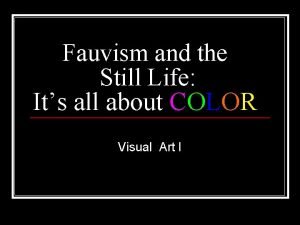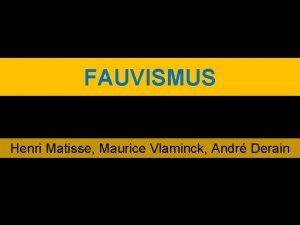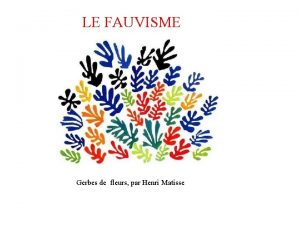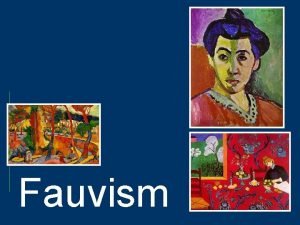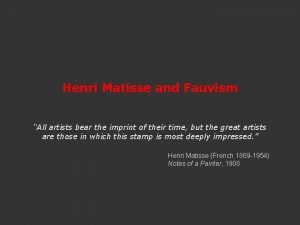What Is Fauvism Fauvism pronounced foevizum is the









- Slides: 9


What Is Fauvism? Fauvism (pronounced foe-viz-um) is the name given to an art movement that took place in the early 20 th century (around 1905 – 1910). It was the first avant-garde movement of the 20 th century. It is known for its strong colours and brushwork. The name Fauvism came from Louis Vauxcelles when he spotted the work of Henri Matisse and Andre Derain in an exhibition.

How and Why Did Fauvism Arise? Fauvism followed the Post. Impressionist movement, where there was structure following the spontaneity of the Impressionist movement. Henri Matisse and other Parisian artists were influenced by these previous movements and began to use flat areas or patches of colours instead of three dimensional space. Many believe that Fauvism is a form of Expressionism.

Characteristics of Fauvism Typical characteristics of Fauvism: • • • Drawings are simple, with simplified shapes. Bright colours are used that are often unnatural and unblended. Most objects or areas are painted flat. Warm and colours are used together. Some areas are outlined by a dark colour.

Critics Louis Vauxcelles, French art critic, came across the work of Matisse and others at an exhibition at the Salon d'Automne in 1905. He spotted the paintings hung together around a more classic sculpture and used the phrase ‘Les Fauves’ to describe them. The name ‘Les Fauves’ was used as a Fauves derogatory. Les remark. derogatory He was referring to the artists’ choice of colours, suggesting that their work was savage and primitive. “Cover of the Catalogue for the 1905 Salon d'Automne, Paris ” by Salon d'Automne is licensed under Creative Commons

Well-Known Work Women with a Hat (1905) Henry Matisse painted this picture of his wife, Amelie. It was exhibited at the Salon d’Automne. This piece was at the centre of the controversy. Many said it looked like a pot of paint had been flung at the canvas. The Green Stripe (1905) Henry Matisse painted this picture of his wife. It is also known as the ‘Portrait of Madame Matisse’. It was an oil painting on canvas. Its name came from the green stripe that divides the face. He was looking to create a sense of shadow without traditional shading.

Try It Yourself Using bright acrylic paints and either a canvas or thick paper, why not create some of your own work in the fauvism style? • Draw a very basic face using pencil. • Apply different colours of paint (perhaps some unnatural) to different areas using a thick brush. Do not blend the colours. • Paint colours in the background that are of contrast to the face. • What does it look like? Does it look like it belongs to the fauvism movement?

Glossary Avant-garde – The name given to new and experimental ideas in art. back Derogatory – To say something that is meant to be critical or disrespectful. back Expressionism – This was a 20 th century art movement where artists expressed emotion through their painting. back Les Fauves – This is French for ‘wild beasts’. back Spontaneity – To take an unplanned course of action. back





